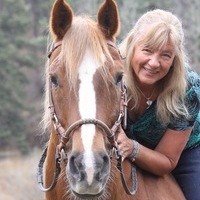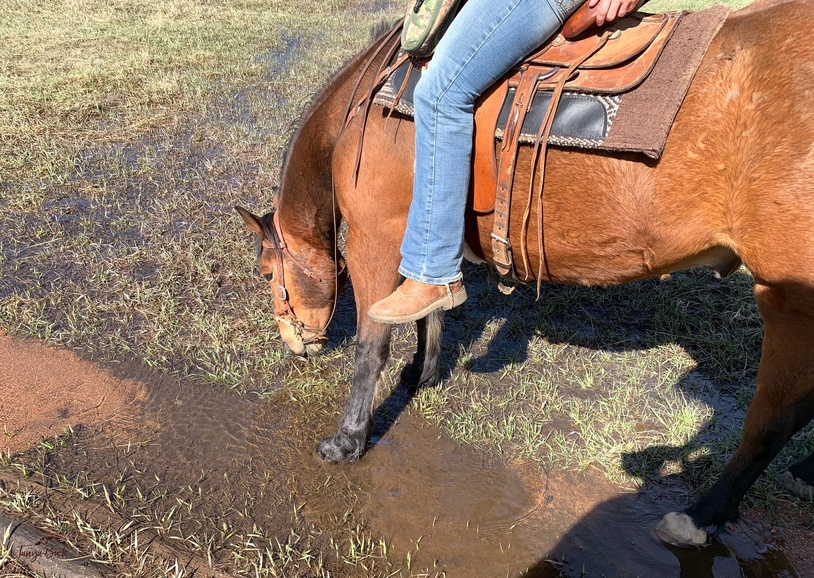Let's face it, while riding, we all come across things--people, bicycles, water crossings, wildlife, leaves, wind, mud, you name it--that your horse may find objectionable. This doesn't mean that the horse is scared of everything (though that may appear to be the case), but it does mean that when he feels that he is no longer safe, his reaction, and consequently, yours, must be manageable.
There is no one correct response when your horse spooks, balks, or spins. Each frightening obstacle to you or your horse dictates a specific action on your part. And, to make it even more interesting, each horse reacts to anything you encounter based on his emotional makeup, personality, and relationship to you.
A bit of a puzzle, isn't it? And so difficult to tell anyone what to do because there are so many underlying factors. The rider's experience, the level of training for the horse, and both of their personalities. The horse's reactivity and the rider's response add another layer to how each situation plays out.
The bottom line is that there is no one response from a rider that will work with every horse, so here, we'll discuss how to best help your horse feel safe and rely on his trust in you, rather than my telling you which button to push to get the desired result.
Most of us have learned that controlling our horses using the harshest tack we can, such as tie-downs, spurs, whips, bits, or whatever, will give us the upper hand over the horse and any obstinate action he may pull. We learned that losing control of the horse meant we'd surely die or at least be seriously maimed and injured. We learned to come to the horse with an attitude of "You will abide by my wishes at all times." And we believed these things because it was the way of our mentors and teachers. Besides, there is some truth to everything we learn about horses; over time, the fine-tuning and understanding over years cause us to question that premise.

Forcing a horse to perform a task does not mean you have control over him. Think about that for a minute. The traditional thought process regarding horses and riding depends on the rider telling the horse what to do and the horse subsequently complying. But what happens when you command the horse, and he refuses? Boom, your illusion of having control is lost, and you become worried, afraid, and perhaps a little frantic. Because face it, if you don't have control over this large animal, you're heading for an unhappy ending. Frightened, you tighten your reins, your heart rate accelerates, and you prepare to flee or fight.
Guess what your horse does? Yep, he follows along and defaults to being the best horse by first keeping himself safe because it is evident to him that you are no longer his protector. In most instances, this means he tenses, his heart rate increases, adrenaline flows like a broken water line, and he spins, rears, bucks, or bolts. Sometimes, he does all of the above.
Whenever we ride, the assumption is that we have some ability to stay on, give natural aids quietly, and are in sync with how our horse is feeling at any given moment. We'd know when he would lose his mind proverbially and stop that from happening. We'd always feel good, and each ride would be fabulous!
Sounds simple, right? I promise you; it is simple. And easy! Now, onto the basics of "What do I do when..."
To confidently ride your horse, it helps to have built a relationship with him that includes a level of trust that neither of you will harm the other. Your job is always to keep your horse safe. Period. Once this caveat is met and understood, the rest is a cakewalk.

In order to build a solid relationship with your horse, begin by creating the following three pillars...
-
You have an open and honest way of communicating. Communication is the first part of the equation towards building trust between you. Does your horse walk with you to where you want without any tack? Does he understand you? Do you know how to always listen to him while being a leader that keeps him safe? If you answered no to any of these questions, get to yes before continuing.
-
You trust each other. Trust between you goes two ways. If you view your horse as an opponent you must conquer, you must always win. For example, if he does not want to do what you want, does he have a voice, or is your winning at all costs matter most to you? A horse is not your equal, but he does have many of the same emotions, wants, and dislikes as any human. To develop trust, we all must feel heard.
-
You can anticipate your horse's emotional state. Because horses are flight animals, predicting when they might sprout those wings, whirl, and dash is essential. Can you tell when your horse is on edge? Teach him how to handle his emotions and look to you for guidance and protection; you're golden!
If these are not one-hundred percent true for you, then fill the potholes so that you can confidently say that the three legs of your tripod are firmly in place. How? Again, easy!
To have a willing and responsive horse, you need to be a protective leader for him. Being peaceful, quiet, and present is the most valuable tool! The more a person thinks about what might happen, what could happen, or what just happened, can't center down and see what IS happening at the moment.
When you take your attention off your horse, even for a second, you tell your horse that you won't always be there for him when something goes wrong.
If the horse is scared and receives support to assuage his fears, he will learn that he can trust his handler to help him. Unafraid, he becomes fearless and is better able to learn. Accepting that you are trustworthy to protect him increases his confidence.

You want to develop an emotional formula for yourself that you implement to help you and your horse in any situation.
The Emotional Formula
-
Your focus, or where you're directing your attention.
-
Your internal dialogue (also known as your self-talk).
-
Your physiology, or how you're using your breath and your body.
Together, these three components create your emotional state. You can influence yourself and your horse if you learn to manipulate your emotions. Who knew?

Here's how the Emotional Formula works when you feel anxious...
Focus: On the future. You imagine a worst-case scenario (falling off, horse spooking, freezing up in the show pen).
Self-talk: Supports your focus with comments like, "I can't do it," "What if I get hurt?" or "I'm capable and can handle this situation and keep myself and my horse safe!"
Physiology: Your body and breath mirror your mental focus. You feel unsettled, your joints are tight, your heart rate climbs, and your breath is short and shallow.
The problem arises when the horse under you decides your fear level is high because you know something he doesn't, so he reacts to keep himself safe. As we all know, he may choose to spin, bolt, buck, or move quickly.

The fix:
Prompt /control your focus on your intent. Concentrate on what you want, not what you're trying to avoid. Ultimately, what would you like to happen with your horse right now? What actions do you need to take to get you there? For example, "I see this ride as easy, safe, and successful."
Prompt/control your self-talk. Ask yourself helpful, encouraging questions. What should I do right now to keep my horse feeling safe? What does my horse need from me to feel focused and confident?
Prompt/control your breath/body. Make each exhalation twice as long as each inhalation; this activates your parasympathetic nervous system to promote relaxation. Adjust your posture into an "I'm confident" frame (chin up, shoulders back, spine erect), then scan through your body, relaxing areas of tension. You'll get so proficient at this that it takes seconds to accomplish!

Lastly, let go a little, and stop holding onto the past. Envision the perfect ride and don’t let any “bad movies” roll through your brain. Allow your horse to feel any emotion he chooses, with confidence that you can help him through the tough spots.
Setting your intent for any ride helps you feel more relaxed and confident. Envisioning yourself as capable and proficient without worry in any situation will help keep your horse willing and soft, Happily Ever After!
~Tanya Buck
www.TanyaBuck.com
Since everyone loves free stuff, here’s a Holiday “Christmas in July” for you. A FREE copy of my novel, White Horse, a time-travel suspense. Imagine being Cheyenne accused of murdering a white woman in the 1870s, while simultaneously setting out to kill in order to save your sister’s life in present day. And what if, in both worlds, the clock is ticking and time is running out?



